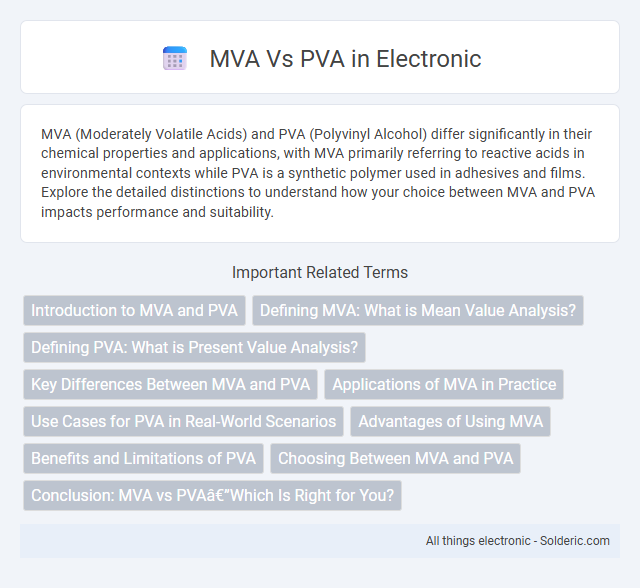MVA (Moderately Volatile Acids) and PVA (Polyvinyl Alcohol) differ significantly in their chemical properties and applications, with MVA primarily referring to reactive acids in environmental contexts while PVA is a synthetic polymer used in adhesives and films. Explore the detailed distinctions to understand how your choice between MVA and PVA impacts performance and suitability.
Comparison Table
| Aspect | MVA (Market Value Added) | PVA (Portfolio Value Added) |
|---|---|---|
| Definition | Difference between a company's market value and the capital invested by shareholders. | Measure of a portfolio manager's performance above a benchmark or required return. |
| Purpose | Evaluates company value creation for shareholders. | Assesses investment portfolio's value added by active management. |
| Calculation | MVA = Market Capitalization - Invested Capital | PVA = Portfolio Return - Benchmark Return |
| Use Case | Corporate finance, shareholder wealth analysis. | Investment management, portfolio performance evaluation. |
| Focus | Company-level value creation. | Portfolio-level active return. |
| Data Required | Market value, invested capital. | Portfolio returns, benchmark returns. |
Introduction to MVA and PVA
MVA (Mean Variance Analysis) and PVA (Present Value Analysis) are essential financial tools used to evaluate investment opportunities and risks. MVA focuses on balancing the trade-off between expected return and risk by analyzing asset portfolios, whereas PVA calculates the current worth of future cash flows using a discount rate to assess investment viability. Understanding how your investment choices align with these methods helps optimize financial decision-making and maximize returns.
Defining MVA: What is Mean Value Analysis?
Mean Value Analysis (MVA) is a mathematical technique used in queuing theory to evaluate the performance of computer and communication networks by estimating metrics such as average queue length, response time, and throughput. MVA calculates these performance measures based on the mean number of jobs in a system and arrival rates, providing insights for multi-server or closed queuing networks. This method enables efficient analysis of resource utilization and system behavior without requiring detailed state probability distributions.
Defining PVA: What is Present Value Analysis?
Present Value Analysis (PVA) evaluates the current worth of future cash flows by discounting them using a specific rate to reflect the time value of money. Unlike Market Value Analysis (MVA), which focuses on the market capitalization relative to invested capital, PVA measures the intrinsic value of investments based on projected earnings and discount factors. This method assists investors in comparing the profitability of projects by quantifying expected returns in today's dollars.
Key Differences Between MVA and PVA
Market Value Added (MVA) measures the difference between a company's market value and the capital invested by shareholders, reflecting overall wealth creation. Present Value Added (PVA) calculates the net present value of expected future economic profits, emphasizing value generated over time through discounted cash flows. While MVA focuses on current market perception, PVA offers a forward-looking assessment based on projected financial performance.
Applications of MVA in Practice
Multivariate Analysis (MVA) finds extensive applications across diverse fields such as finance, marketing, and healthcare for pattern recognition, risk management, and decision-making processes. Techniques like Principal Component Analysis (PCA) and Cluster Analysis help in reducing dimensionality and identifying natural groupings in complex data sets. Your ability to leverage MVA enables enhanced insights from large-scale data, leading to optimized strategies and predictive accuracy.
Use Cases for PVA in Real-World Scenarios
PVA (Process Virtualization Architecture) excels in automating complex workflows and integrating multiple data sources, making it ideal for customer service bots, virtual assistants, and task automation in enterprises. Your business can leverage PVA to enhance efficiency in handling repetitive queries, streamlining support processes, and enabling conversational AI for personalized user interactions. Unlike MVA, which focuses more on model-driven development, PVA's strength lies in real-time communication and adaptive responses within dynamic environments.
Advantages of Using MVA
MVA (Market Value Added) offers a clear measure of a company's value creation by comparing market capitalization with invested capital, providing investors insight into management's effectiveness at generating wealth. It reflects real-time market perceptions, enabling a dynamic assessment of corporate performance beyond accounting profits, unlike PVA (Profit Value Added), which focuses solely on profitability. MVA's ability to highlight shareholder value creation supports strategic decision-making and aligns management incentives with long-term growth objectives.
Benefits and Limitations of PVA
Polyvinyl alcohol (PVA) offers excellent film-forming, emulsifying, and adhesive properties that make it superior to methyl vinyl acetate (MVA) in applications such as coatings, textiles, and paper coatings. PVA's biodegradability and non-toxic nature contribute to its environmental benefits, enhancing your product's sustainability profile. However, PVA has limitations including lower resistance to moisture and chemical solvents compared to MVA, which may impact its performance in harsh or highly aqueous environments.
Choosing Between MVA and PVA
Choosing between Market Value Added (MVA) and Present Value Added (PVA) depends on a company's financial goals and evaluation focus. MVA measures the difference between a firm's market value and the capital invested, reflecting long-term wealth creation. PVA emphasizes discounted future cash flows, making it ideal for assessing project-specific profitability and investment viability.
Conclusion: MVA vs PVA—Which Is Right for You?
MVA screens provide wider viewing angles and better color accuracy, making them ideal for graphic design and multimedia tasks, whereas PVA panels excel in contrast ratios and black levels, perfect for gaming and video consumption. Your choice depends on whether color precision or deep blacks are more critical for your specific usage. Consider MVA for color-critical workflows and PVA if immersive visual depth and contrast are priorities.
MVA vs PVA Infographic

 solderic.com
solderic.com